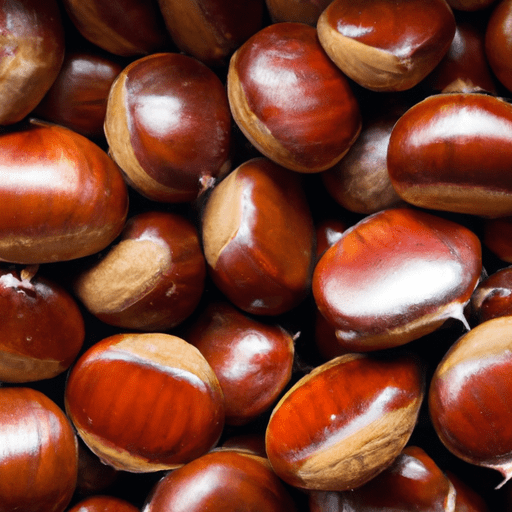The Wonderful World of Chestnuts

Chestnuts, with their autumnal charm, are more than just a festive treat. Their rich history, unique taste, and versatility in the kitchen make them a beloved ingredient worldwide. Today, let’s dive into the wonderful world of chestnuts and explore everything you need to know about these delicious nuts.
The Taste of Chestnuts
Chestnuts have a distinct and delightful flavor. When cooked, their texture becomes soft and buttery, with a subtly nutty and sweet taste. The flavor profile varies slightly depending on the type of chestnut and the cooking method used. From creamy to earthy, chestnuts add a unique touch to both sweet and savory dishes.
Common Uses in Cooking
Chestnuts have an extensive culinary repertoire. Their versatility allows them to be used in various forms - roasted, boiled, puréed, or even ground into flour. Here are some common ways to enjoy chestnuts in your kitchen:
Roasted Chestnuts: A beloved winter snack, roasted chestnuts bring warmth and nostalgia. Slashed with a knife and cooked over an open fire or oven, they make a delightful treat on chilly days.
Stuffings and Dressings: Chestnuts add a wonderful depth of flavor to stuffings and dressings for poultry, game, or vegetarian dishes. Their sweet and savory attributes complement other ingredients perfectly.
Soups and Stews: Pureed chestnuts lend a velvety texture and nutty taste to soups and stews. Whether used as a thickener or an essential flavor component, they elevate the overall dining experience.
Chestnut Flour: Ground chestnut flour, gluten-free and rich in nutrients, is a fantastic alternative to grain-based flours. It adds a delicate sweetness to baking goods such as bread, cakes, and pastries.
Nutritional Value of Chestnuts
Beyond their delightful taste, chestnuts also offer impressive nutritional benefits. Here’s a glimpse into what these powerhouse nuts have to offer:
Low in Fat: Chestnuts have lower fat content compared to other nuts. Their fats mainly consist of healthy monounsaturated fats, which are beneficial for heart health.
Good Source of Fiber: Rich in dietary fiber, chestnuts can aid digestion and promote a healthy digestive system.
High in Vitamins and Minerals: Chestnuts are packed with vitamins, including vitamin C, vitamin B6, and folate. Additionally, they provide essential minerals like potassium, magnesium, and copper.
Gluten-Free and Low Cholesterol: Chestnuts are naturally gluten-free and contain no cholesterol, making them a suitable choice for individuals with specific dietary needs.
History and Fun Facts
Chestnuts have a long and storied history. Here are a few fascinating facts about these beloved nuts:
Global Delicacy: Chestnuts have been a traditional food source in many cultures worldwide, from Asia to Europe, and even in parts of the Americas.
Symbol of Abundance: In some regions, chestnuts were considered a symbol of abundance and prosperity, often associated with autumn harvest festivals.
Ancient Staple Food: Chestnuts played a crucial role in the diet of ancient civilizations like the Romans and Greeks. They were often ground into flour and used as a staple food during winter months.
Chestnut Trees: Chestnuts grow on majestic trees that can live for centuries. These trees have a distinctive appearance, with broad, dark green leaves that flutter in the wind.
Chestnut Roasting: The time-honored tradition of roasting chestnuts on an open fire gained popularity in Europe during the Middle Ages. Today, it remains a cherished seasonal activity in many countries.
Now that you’ve discovered the wonders of chestnuts, why not try incorporating them into your next culinary adventure? From festive feasts to cozy autumnal recipes, these versatile nuts bring both flavor and nutrition to the table. So, embrace the warmth and richness of chestnuts and let your taste buds embark on a delightful journey!
Chestnut
Origin: Chestnuts are native to the temperate regions of the Northern Hemisphere, including Europe, Asia, and North America. They have been cultivated for thousands of years and have a long history of culinary uses.
Common Uses: Chestnuts are commonly used in both sweet and savory dishes. They can be roasted, boiled, or steamed and used in stuffing, soups, stews, desserts, and more. They are also a popular ingredient in chestnut flour, which is used in baking and cooking.
Nutritional Benefits: Chestnuts are low in fat and calories compared to other nuts. They are a good source of fiber, vitamin C, potassium, and folate. They also contain antioxidants and minerals like calcium, magnesium, and iron.
Unique Properties: Unlike other nuts, chestnuts are high in carbohydrates and low in protein and fat. They have a slightly sweet and nutty flavor, with a soft and slightly grainy texture when cooked. Chestnut shells are prickly and require careful handling.
Historical Significance: Chestnuts have been an important food source throughout history. They have been consumed by various cultures, including the ancient Greeks and Romans. In Europe, chestnuts were traditionally known as the “bread of the poor” as they were a staple food during times of scarcity. They played a significant role in the Mediterranean diet and were widely consumed until the early 20th century when a chestnut blight devastated many chestnut trees.




Use the share button below if you liked it.
It makes me smile, when I see it.